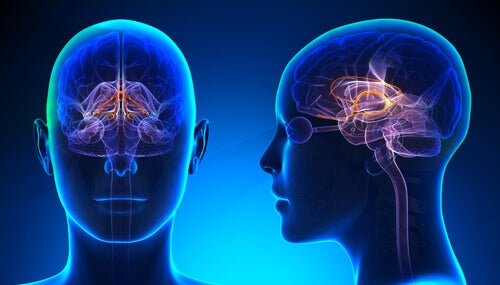The Neuroanatomy of Emotions: The Limbic System

In order to describe the neuroanatomy of emotions, Paul Broca first described the limbic system in 1878. It wasn’t until later, in the 1930s, that James Papez finally named it the limbic system, and suggested that it participated in the neural circuit of emotional expression (Kolb and Whishsaw, 2003).
The limbic system corresponds to a functional concept including several neural structures and networks, which play a prominent role in emotional aspects. And since it involves emotional manifestations, it’s also related to motivation. More concretely, it’s related to action, learning, and memory-oriented motivation. In fact, it’s easier to remember or learn something that has a high emotional value (Cardinali, 2005).
The neuroanatomy of emotions: beyond brain structures
Several authors suggest that emotional responses not only involve the nervous system. In fact, experts believe that other systems, such as the immune and endocrine systems, participate in this process. For instance, Damasio (2008) introduced the somatic marker hypothesis, which states that what makes an experience valuable isn’t just cognitive evaluation but a certain somatic state as well.
A somatic state is a result of the activation of complex subcortical neurohumoral circuits that give emotional value and relevance to a certain thought.

The limbic system and other command systems
Some important research studies have defined more specific systems than the limbic system. For example, in his studies on affective neurosciences, Jaak Panksepp (2001) conceptualized systems based on primary emotions: sadness, fear, and rage, among others. The main ones are:
Seeking/expectancy system
This system motivates the pursuit of pleasure; it activates a person’s interest in the world. It’s circuits run on dopamine. Furthermore, some neuroscientists believe it’s similar to Freudian libido and lust (Bleichmar, 2001; Solms and Turnbull, 2005).
The expectancy system is part of the mesolimbic/mesocortical system, which operate simultaneously and affect each other, forming the so-called extended amygdala (Cardinali, 2005).
Natural pleasurable stimuli (such as food or sex) and addictive drugs promote dopamine release, which takes place in the ventral tegmental area (VTA) neurons. These send projections to the nucleus accumbens and finally translate into euphoria and behavior reinforcement. When this system is highly stimulated, an individual will seek pleasurable sensations (Leira, 2012).
Rage/anger system
- Originates due to frustration toward an object, person, or situation.
- Physical manifestations include “fight” motor programs, such as jaw clenching or yelling.
- In addition, the activity originates in the amygdala toward the stria terminalis and the hypothalamus.
Fear/anxiety system
- It mainly involves the amygdala.
- Responses such as “fight” and “escape” stem from the amygdala’s lateral and central nuclei, which respectively send projections to the medial and anterior part of the hypothalamus.
Panic/sadness system
- Associated with feelings of loss and sadness.
- It’s seemingly related to social interactions and bonding and especially with the maternity process and attachment behaviors.
- Endogenous opioids take part in this system. Separation or loss of something with affective value leads to reduced concentration of the endogenous opioids, which determine a painful experience.
- Biological foundation. The anterior cingulate gyrus and its projections to the thalamus and hypothalamus toward the ventral tegmental area.

Inhibition and regulation of the prefrontal cortex emotional responses
The previous command systems need experiences in order to develop. Thus, with voluntary actions, the external world information coming through association areas goes to the prefrontal cortex, which then connects with the motor system. As per involuntary actions in which there are emotional reactions, subcortical areas mediate actions (such as the command systems we mentioned above).
In the neuroanatomy of emotions, the prefrontal cortex regulates emotional responses. It takes place in the ventral medial area, acting as an inhibitor, and in the lateral area. The latter has more of a controlling function of conscious thoughts. It’s the protagonist in the learning, planning, and decision-making processes.
Therefore, childhood experiences will shape the inhibitory system in formation, which also explains the differences in emotional regulation in children and adults.
In order to describe the neuroanatomy of emotions, Paul Broca first described the limbic system in 1878. It wasn’t until later, in the 1930s, that James Papez finally named it the limbic system, and suggested that it participated in the neural circuit of emotional expression (Kolb and Whishsaw, 2003).
The limbic system corresponds to a functional concept including several neural structures and networks, which play a prominent role in emotional aspects. And since it involves emotional manifestations, it’s also related to motivation. More concretely, it’s related to action, learning, and memory-oriented motivation. In fact, it’s easier to remember or learn something that has a high emotional value (Cardinali, 2005).
The neuroanatomy of emotions: beyond brain structures
Several authors suggest that emotional responses not only involve the nervous system. In fact, experts believe that other systems, such as the immune and endocrine systems, participate in this process. For instance, Damasio (2008) introduced the somatic marker hypothesis, which states that what makes an experience valuable isn’t just cognitive evaluation but a certain somatic state as well.
A somatic state is a result of the activation of complex subcortical neurohumoral circuits that give emotional value and relevance to a certain thought.

The limbic system and other command systems
Some important research studies have defined more specific systems than the limbic system. For example, in his studies on affective neurosciences, Jaak Panksepp (2001) conceptualized systems based on primary emotions: sadness, fear, and rage, among others. The main ones are:
Seeking/expectancy system
This system motivates the pursuit of pleasure; it activates a person’s interest in the world. It’s circuits run on dopamine. Furthermore, some neuroscientists believe it’s similar to Freudian libido and lust (Bleichmar, 2001; Solms and Turnbull, 2005).
The expectancy system is part of the mesolimbic/mesocortical system, which operate simultaneously and affect each other, forming the so-called extended amygdala (Cardinali, 2005).
Natural pleasurable stimuli (such as food or sex) and addictive drugs promote dopamine release, which takes place in the ventral tegmental area (VTA) neurons. These send projections to the nucleus accumbens and finally translate into euphoria and behavior reinforcement. When this system is highly stimulated, an individual will seek pleasurable sensations (Leira, 2012).
Rage/anger system
- Originates due to frustration toward an object, person, or situation.
- Physical manifestations include “fight” motor programs, such as jaw clenching or yelling.
- In addition, the activity originates in the amygdala toward the stria terminalis and the hypothalamus.
Fear/anxiety system
- It mainly involves the amygdala.
- Responses such as “fight” and “escape” stem from the amygdala’s lateral and central nuclei, which respectively send projections to the medial and anterior part of the hypothalamus.
Panic/sadness system
- Associated with feelings of loss and sadness.
- It’s seemingly related to social interactions and bonding and especially with the maternity process and attachment behaviors.
- Endogenous opioids take part in this system. Separation or loss of something with affective value leads to reduced concentration of the endogenous opioids, which determine a painful experience.
- Biological foundation. The anterior cingulate gyrus and its projections to the thalamus and hypothalamus toward the ventral tegmental area.

Inhibition and regulation of the prefrontal cortex emotional responses
The previous command systems need experiences in order to develop. Thus, with voluntary actions, the external world information coming through association areas goes to the prefrontal cortex, which then connects with the motor system. As per involuntary actions in which there are emotional reactions, subcortical areas mediate actions (such as the command systems we mentioned above).
In the neuroanatomy of emotions, the prefrontal cortex regulates emotional responses. It takes place in the ventral medial area, acting as an inhibitor, and in the lateral area. The latter has more of a controlling function of conscious thoughts. It’s the protagonist in the learning, planning, and decision-making processes.
Therefore, childhood experiences will shape the inhibitory system in formation, which also explains the differences in emotional regulation in children and adults.
All cited sources were thoroughly reviewed by our team to ensure their quality, reliability, currency, and validity. The bibliography of this article was considered reliable and of academic or scientific accuracy.
-
Bleichmar, H. (2001). El cambio terapéutico a la luz de los conocimientos actuales sobre la memoria y los múltiples procesamientos inconscientes. Aperturas psicoanalíticas, 9(2).
- Cardinali, D. (2005), Manual de Neurofisiología, (9ª. Edición), Buenos Aires, Mitre Salvay.
- Damasio, A. R. (2008), El error de Descartes, Buenos Aires, Crítica.
- Kolb, B. y Whishaw, I. (2003), Neuropsicología Humana, (5a. Edición), Buenos Aires, Panamericana.
-
Leira, M. (2012). Manual de bases biológicas del comportamiento humano.
-
Pankseep, J., Afectos, E., & Panksepp, P. (2001). Las emociones vistas por el psicoanálisis y la neurociencia: un ejercicio de conciliación. Revista Aperturas Psicoanalíticas, 7.
-
Solms, M., Turnbull, O., Sacks, O., & Jaramillo, D. (2004). El cerebro y el mundo interior: una introducción a la neurociencia de la experiencia subjetiva. Fondo de Cultura Económica.
This text is provided for informational purposes only and does not replace consultation with a professional. If in doubt, consult your specialist.







